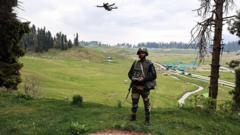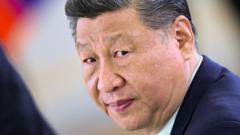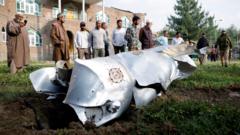India and Pakistan find themselves in the throes of their most intense military conflict in decades, triggered by a recent terrorist attack. As both nations engage in escalating aerial strikes and ground bombardment, the potential for a wider war looms ever larger, sparking panic among civilian populations and drawing international attention.
Escalating India-Pakistan Tensions: A Comprehensive Overview

Escalating India-Pakistan Tensions: A Comprehensive Overview
The ongoing conflict between India and Pakistan sees unprecedented military engagement, leading to fears of a wider war.
Amid rising tensions, the ongoing conflict between India and Pakistan has reached alarming levels, becoming the most expansive military engagement in decades. This escalation was ignited following a deadly terrorist attack in India-controlled Kashmir, where 26 people were killed, prompting retaliatory airstrikes by India, which reportedly targeted sites in both Pakistan and Pakistani-controlled Kashmir. On Wednesday, Indian forces struck deeper into Pakistani territory than seen in years, marking a significant shift in military strategy.
Reports indicate relentless shelling along the borders, with both nations accusing each other of extensive missile strikes and drone attacks. Tensions boiled over as the Indian military declared a full-scale operation against what they termed "terrorist infrastructure" across the border, while Pakistan’s military rejected these claims, asserting that India had attacked civilian areas.
The situation reflects a new era in warfare, with drones playing a pivotal role in operations. This use of technology has also coincided with a surge of disinformation, complicating the media landscape with contradictory narratives. Reports of attacks have been met with claims from both governments denying the extent and implications of military actions taken.
In addition to the ground conflict, fears of escalation are further compounded by a regional reshuffle in arms procurement. India, now heavily reliant on Western military supplies, has sought to fortify its defenses, while Pakistan has turned to China for a majority of its arms. This shift has elevated concerns that superpower politics are deeply entwined with the longstanding conflict over Kashmir.
Although diplomatic discussions are underway with the involvement of regional powers like Saudi Arabia and Iran, the immediate future appears uncertain. A notable increase in civilian military drills and evacuations in border towns exemplifies the fear gripping local populations. Schools have closed in various regions, and the broader Indian public is stockpiling resources amid fears of a potential full-scale war.
The implications of this conflict extend beyond military engagement; it poses significant humanitarian risks, heightening the existing fears surrounding water security due to threats against the Indus Waters Treaty. Given the stark realities in a precarious nuclear landscape, the risk of a miscalculation leading to uncontrollable escalations remains a grave concern.
As both nations brace for potential retaliatory actions, the world watches closely, with hopes that diplomatic efforts will rein in the rapidly spiraling situation before it descends into broader chaos.


















